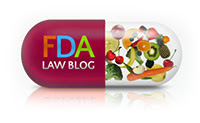Posted: 09 Sep 2020 07:40 PM PDT By Kurt R. Karst —
During these unprecedented times, Hyman, Phelps & McNamara, P.C. is pleased to bring you the next installment of our quarterly newsletter highlighting key postings from our nationally acclaimed FDA Law Blog. Please subscribe to the FDA Law Blog to receive contemporaneous posts on regulatory and enforcement activities affecting the broad cross-section of FDA-regulated industry. As the largest dedicated FDA law firm, we are happy to help you or your clients navigate the nuances of the laws and regulations affecting them.
***************************** DEA- Larry Houck deciphers the Drug Enforcement Administration’s (DEA) stated justification of its recent increase of registration and renewal fees affecting facilities handling controlled substances. Houck analyzes the underlying fee calculation methodology as well as the conditions under which DEA will refund registration fees.
Medical Devices- Gail Javitt, Jeffrey Gibbs, Richard Lewis, and McKenzie Cato provide a “mid-mortem” analysis of FDA’s response to COVID-19 and propose potential areas of improvement. The authors review FDA’s policy concerning laboratory developed tests, a lack of regulatory predictability for serological tests, unclear communication from the Agency regarding changing review priorities, and an over-extension of FDA’s capabilities leading to industry frustration over a lack of feedback.
- Jeffrey Shapiro answers the difficult question of whether a company can lawfully advertise a device that has a pending Emergency Use Authorization (EUA). Shapiro undertakes a close reading of the pertinent FDA policy, Compliance Policy Guide (CPG) 300.600, that has stood for over 40 years and, in the absence of FDA clarification, opines on whether such promotion is allowed.
Food Labeling- Riëtte van Laack describes FDA’s temporary guidance providing flexibility to food manufacturers facing COVID-19-related supply chain issues, and permits manufacturers to substitute hard-to-get ingredients in food labeling. This is FDA’s fifth announcement of flexibility regarding food labeling regulations.
Drug Development- Deborah Livornese discusses FDA’s guidance as it applies to “compassionate use” determinations by investigational review boards (IRBs) and clinical investigators when reviewing individual patient access requests. FDA issued this guidance in response to a substantial uptick in the number of requests for COVID-19 investigational drugs.
- In this post, Mark Schwartz describes FDA’s proposed review standards for COVID-19 vaccines under the public-private partnership Operation Warp Speed. Operation Warp Speed heralds questions and concerns such as undue political pressure as well as risks from a potentially abbreviated review cycle and novel technological platforms.
- Larry Bauer and James Valentine detail their experiences with adapting externally led patient-focused drug development (EL-PFDD) meetings to adjust to the unprecedented disruptions presented by COVID-19. In the face of social distancing, mask requirements, and other efforts to “flatten the curve,” HPM and several patient communities have successfully come together to represent and capture the voice of patients, as well as caregivers, regarding disease symptoms, the impacts of those symptoms on daily life, current treatments, and hopes for future treatments. As of August 28, 2020, there have been five virtual EL-PFDD meetings.
Healthcare- Alan Kirschenbaum, Michelle Butler, and Faraz Siddiqui discuss a proposed rule published by the Centers for Medicare & Medicaid Services (CMS) that seeks to implement statutory amendments to the Medicaid Rebate Program statute while also including CMS’s own policy proposals concerning value-based purchasing arrangements and patient copay assistance.
- In this post, Faraz Siddiqui and Alan Kirschenbaum describe litigation vacating a drug price transparency rule published by the CMS. This rule would have required pharmaceutical manufacturers to disclose the Wholesale Acquisition Cost (WAC) in direct-to-consumer advertisements for certain prescription drugs and biological products.
Litigation- Anne Walsh and John Fleder highlight a recent Supreme Court decision, Liu v. Securities and Exchange Commission, that may lead to future challenges to FDA’s and the Federal Trade Commission’s (FTC) presumed ability to secure disgorgement and restitution awards. Indeed, since publication of the post, the Supreme Court granted the petition for a writ of certiorari in FTC v. Credit Bureau Center, so look for our next update on this litigation.
- Karin Moore describes a D.C. Circuit Court decision striking down FDA’s regulations requiring extensive health warnings on packaging and in advertising for cigars and pipe tobacco. The court found that FDA had violated both the Tobacco Control Act (TCA) and the Administrative Procedure Act (APA) by failing to study the effectiveness of such health warnings.
***************************** Hyman, Phelps & McNamara, P.C. has its finger on the pulse of FDA law. Our technical expertise and industry knowledge are exceptional in scope and depth. Our professional team holds extensive experience with the myriad of issues faced by companies. Please contact us with any questions you may have related to the issues described here or any other FDA-related issue affecting your industry. See our award-winning FDA Law Blog: http://www.fdalawblog.net/ |






















.png)









No hay comentarios:
Publicar un comentario